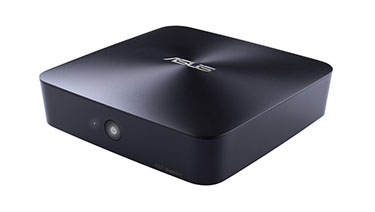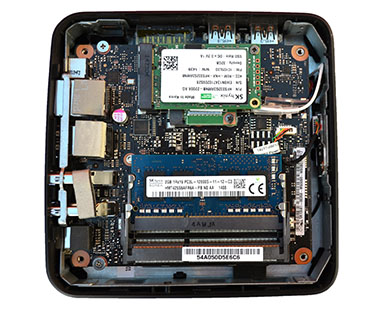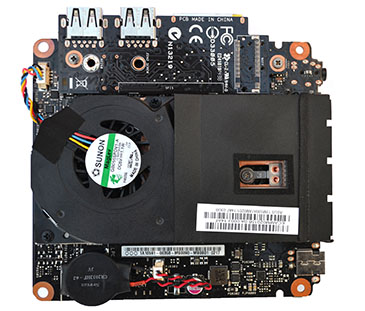Introduction
The Intel Next Unit of Computing (NUC) attempts to redefine the usefulness of small-form-factor PCs. Deliberately tiny in size due to the chip giant integrating reasonable graphics alongside potent CPU cores, the itty-bitty PC is a very sensible fit for a wide range of users.
Intel is expanding the NUC range through each processor generation, with upcoming Broadwell-based machines smaller and more capable than ever before. Others have seen the merits of housing Intel's latest processors inside chassis substantially smaller than a typical ATX PSU; Gigabyte has the ever-expanding BRIX range while Asus ploughs the field with the slightly larger VivoPC and, lately, the sleeker, smaller VivoMini.
Said VivoMini is available in either UN42 or UN62 configurations, and both models are based on the same diminutive chassis but feature either Celeron 2957U (UN42), Core i3-4030U or Core i5-4210U (UN62) processors. Asus provides further flexibility by offering each VivoMini in barebones or turnkey forms - the latter complete with memory, storage, wireless connectivity and either Windows 8.1 with Bing or Windows 7 operating systems.
Physical examination
In its most basic form the Celeron-powered barebones VivoMini costs £120. Upping the outlay to £190 provides a ready-to-roll system primed as a quiet, simple home PC. Let's take a look.
Not quite as small as the latest Intel NUCs, the 131x131x42mm (WxDxH) footprint ensures the VivoMini is unobtrusive, taking up about as much space as three Blu-ray cases stacked on top of each other. A rubberised base provides a firm grip on most surfaces and, should you so wish, the VivoMini can be VESA-mounted behind a monitor or TV.
Build quality is up to Asus's usual high standards, and though the entire chassis is made from plastic in order to keep costs in check, there are no squeaks or rattles that afflict inferior models. The curved lid has a miniature weave pattern that reflects light in subtle ways, lending an air of quality on what would otherwise be a very generic-looking box.
A main power button is ringed with a white LED and flanked to the left by a tiny storage activity light, and it's a shame that neither can be turned fully off. We agree with Asus that it makes sense to keep the peripheral and connectivity ports out of the way, so to the left there's a couple of USB 3.0 and a multi-card reader while on the back, below the air vents, Asus situates the power point for the external fanless 65W adapter, full-size HDMI and DisplayPort, two further USB 3.0, Gigabit Ethernet and a headphone output: all sensible stuff.
Getting inside, necessary if building up a barebones unit, is accomplished by removing four rubber-covered screws on the bottom. The built-up unit features a meagre 2GB of Hynix DDR3 memory and a 32GB Hynix mSATA drive sitting on top of an AzureWare WiFi/Bluetooth combo module that usefully, supports the faster AC standard. Flipping it over shows the one-piece heatsink cooled by a Sunon fan commonly found on laptops.
The fan remains switched on at all times, happily spinning away at 2,000-2,500rpm, yet it's well-engineered and very quiet - you need to have an ear right next to the unit to know it's cooled actively, and it's definitely quieter than the 40mm spinner in the earlier NUCs. The chosen dual-core Celeron 2957U operates at a maximum 1.40GHz and, with a U-series designation, chews through no more than 15W. Certainly not a shade on the full-on Core i3 or i5 series available in the next model up, UN62, it should be good enough for bog-standard tasks it's designed for.
Integration and use
It takes about 25 seconds from cold boot to usable Windows 8.1. Approximately 10GB of the nominal 32GB capacity is taken up by the operating system and basic applications leaving, you would think, about 20GB for your own programs. Annoyingly this is not the case as this configuration of the UN42 reserves a hidden 13GB partition for recovery purposes. The upshot is that users have less than 7GB of usable space.
Asus partially circumvents this problem by offering 100GB of company-specific webstorage for a year on top of 100GB of OneDrive storage for two years, but we'd much rather see more on-device space as standard - you soon eat into that remaining 7GB.
Given the potentially anemic benchmarking performance when compared to a full Core series processor, the VivoMini UN42 makes more sense as a basic PC and home theatre box. A potential snag, more so for the future, is the inability of the Celeron's baked-in HD Graphics to support a 4K resolution over DisplayPort; Intel purposely leaves this feature for the dearer Core products.
But the VivoMini has no issues in playing regular HD content with the minimum of fuss, with the CPU utilisation rarely exceeding a few per cent. General browsing and day-to-day performance isn't as electric as on a Core-based machine outfitted with a fast SSD, mind, so don't expect this tiny PC to replace boxes that are used for anything more strenuous than high-definition video playback - you will see why in our upcoming benchmarks.













